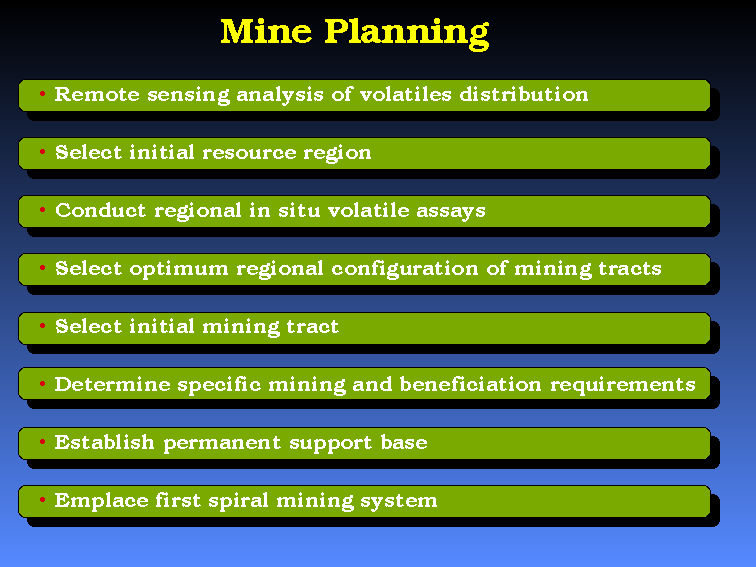NEEP602 Course Notes (Fall 1996)
Resources from Space
Lecture #19 There's Helium in Them Thar Craters!
Title: Lunar Mine Planning
Notes:
Survey of types of Mines Required
Principal Mining and Beneficiation Constraints
- natural (geological) controls of resource distribution
- predictability of significant variations in host material
- energy source(s) and schedule of availability
- degree of reliable automation possible
- equipment reliability
- number and skill of human support
- waste "rock" disposal
- location and influence of blocky-rim craters
- location of refining facility
- location of permanent support base
Principal Resource Separation Constraints
- predictability of significant variations in "concentrate"
- energy source(s) and schedule of availability
- waste heat recovery technology
- degree of automation possible
- equipment reliability
- amount and skill of human support
- waste "rock" disposal
Mining Requirements for One Tonne 3He
- recoverable grade assumed: 20 ppb
- regolith density assumed: 1.5 g/cm2
-
Regolith and Pyroclastic Volatiles -
- Surface Bulk Tonnage Continuous Mining (~terrestrial dredging)
- Robotic with human intervention
- In situ beneficiation and thermal extraction
- Waste heat recovery
- Regolith waste disposal in mined track
- Craters less than 10 meters in diameter destroyed
- No major change in surface albedo
Centralized volatiles refining
- Permanent Base
- Periodically Mobile Base
Regolith minerals (extraction of metals, oxygen, aggregate, and sintering material might be combined with regolith volatiles mining)
- Robotic with human intervention
- In situ beneficiation and physical-property-based separation (magnetic susceptibility, size fraction, density, optical properties)
- Regolith waste disposal in mined track
- Craters less than 10 meters in diameter destroyed
- No major change in surface albedo
Primary minerals (as layers in basalt cooling units)
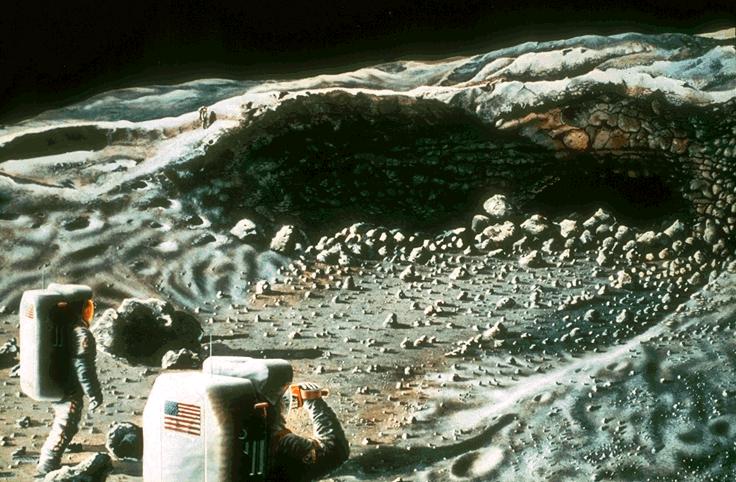 Lava tube (NASA art
S88-33546)
Lava tube (NASA art
S88-33546)
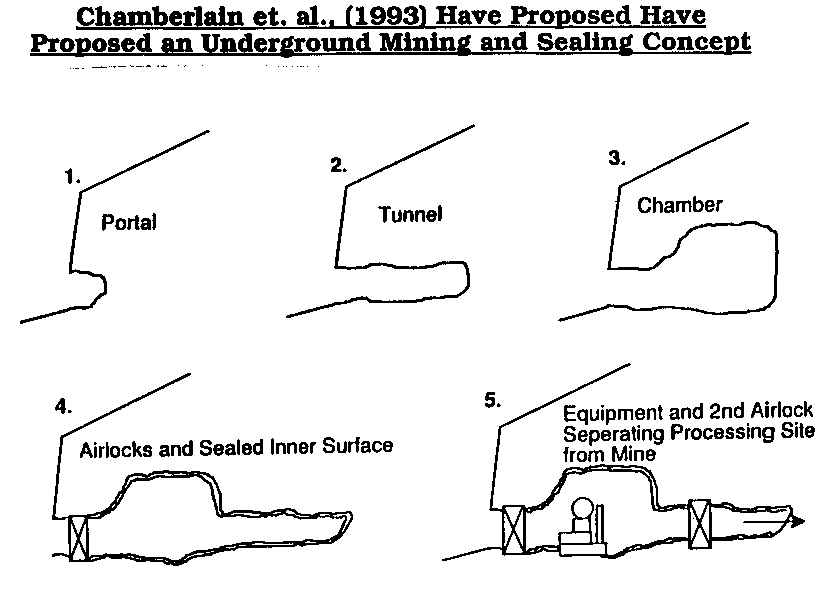 Mining and Sealing Concept (after Chamberlain, et al.,
1993)
Mining and Sealing Concept (after Chamberlain, et al.,
1993)
- Robotic "long wall" continuous mining with close human intervention
- Continuous ore transport to surface with close human intervention
- Surface beneficiation and physical-property-based separation (magnetic susceptibility, size fraction, density, optical properties)
- Waste rock disposal at surface (in craters or as mounds if not useful as aggregate)
- Waste disposal may change topography
- Major changes in albedo where waste rock disposed
Achievable Timing for Lunar Mining Operations
 Possible Schedule to
2020
Possible Schedule to
2020
-
2000: Orbital Remote Sensing of Favorable Mare Regions -
- (Coincident with financial commitment to develop commercial 3He fusion)
-
2005: Automated Roving Exploration of Favorable Mare Region (INTERLUNE-One) - (Coincident with first demonstration of sustained 3He fusion reaction)
-
2015: Base and Pilot Plant Activation in Selected Mining Region - (Coincident with first 3He reactor prototype operation)
-
2020: First Miner Activation - (Coincident with first commercial reactor demand for 3He)
-
Mine Planning and Mining Concepts for Lunar Resources
Rectilinear Mining (Cameron, 1992) -
-
General Concept of Rectilinear Mining
- Mining progresses linearly, filling rectilinear blocks
- All mining, beneficiation, and volatile extraction and waste heat recovery contained in miner
- Interim storage of extracted volatiles in pressurized tanks
- Tanks transported to central refining location
- Refining plant and storage and shipment facilities are part of a permanent lunar base
- Lunar base includes long duration, full service, support facilities
- New base required when mining operations reach the practical and/or economic limits of support
-
Cameron (1992) analyzed the resource base and the minability of Mare Tranquillitatis
Useful illustration of an early stage of mine planning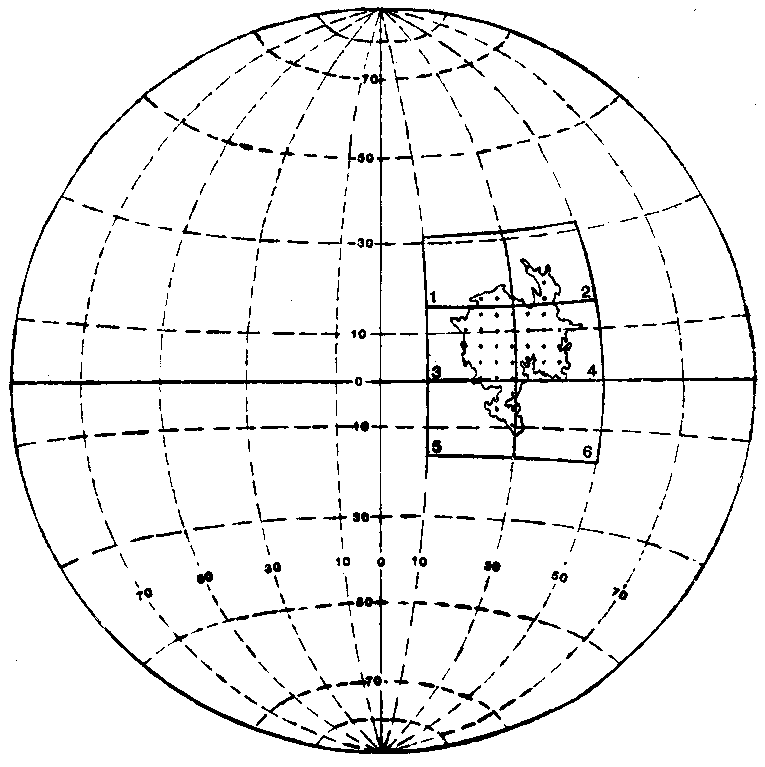 Location of Mare
Tranquillitatis
Location of Mare
Tranquillitatis
- The regolith covering the 300,000 km2 of Mare Tranquillitatis is a major resource for 3He
-
28% has
20-30 wppm He
- 65% has 30-45 wppm He
-
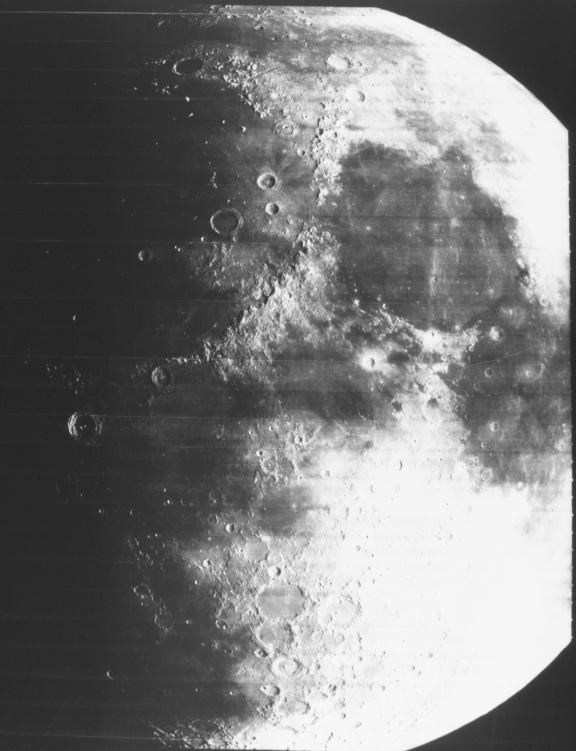 Mare
Tranquillitatis
Mare
Tranquillitatis
Distribution of High-Ti regolith: Inferred Titanium
Content of Regolith of Mare Tranquillitatis
Inferred Titanium
Content of Regolith of Mare Tranquillitatis
- The most favorable area for initial mine operations is 85,000 km2 in the northeast
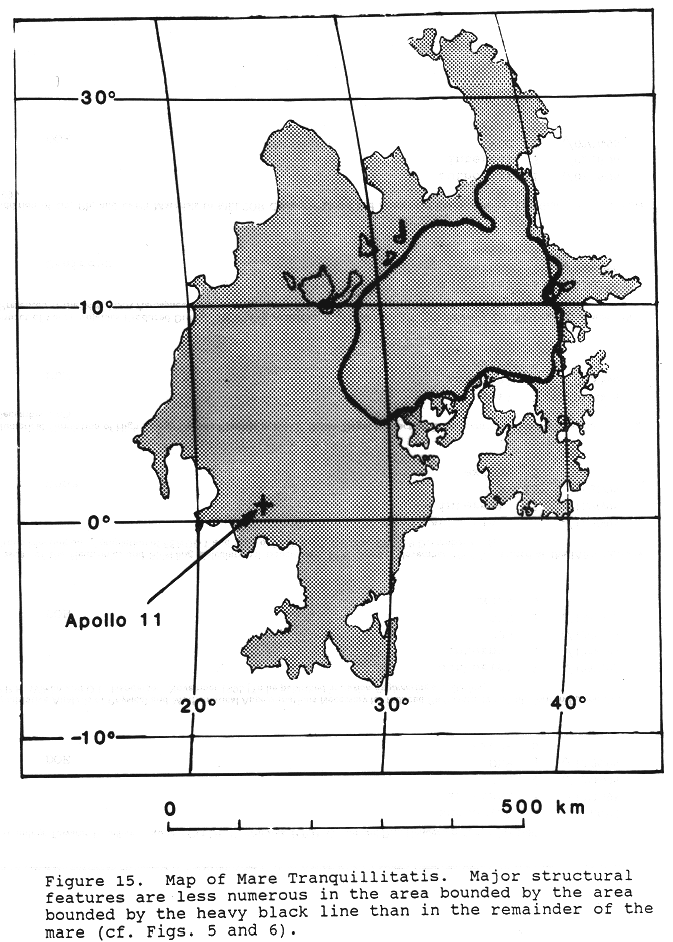 Most favorable mine
area
Most favorable mine
area
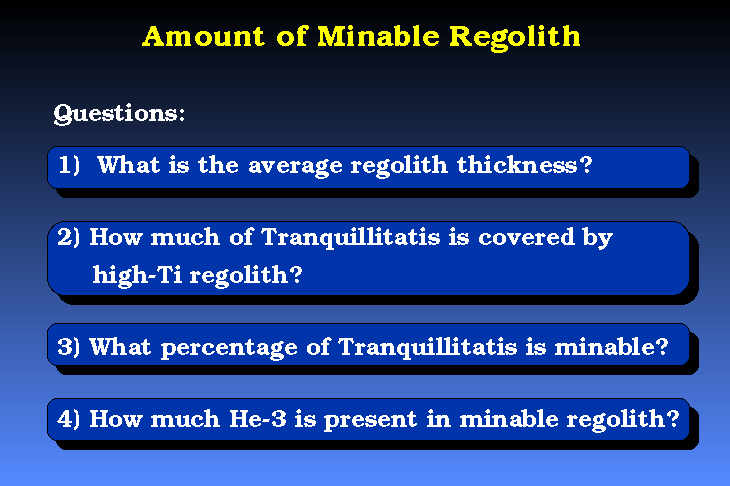 Amount of Minable
Regolith
Amount of Minable
Regolith
 Percentage of the Total Area of Mare
Tranquillitatis Occupied by Major Features
Percentage of the Total Area of Mare
Tranquillitatis Occupied by Major Features
 Minable Regolith and
Helium Content of Mare Tranquillitatis
Minable Regolith and
Helium Content of Mare Tranquillitatis
Rectilinear mining plan 400m mining blocks
400m mining blocks
 300m mining blocks
300m mining blocks
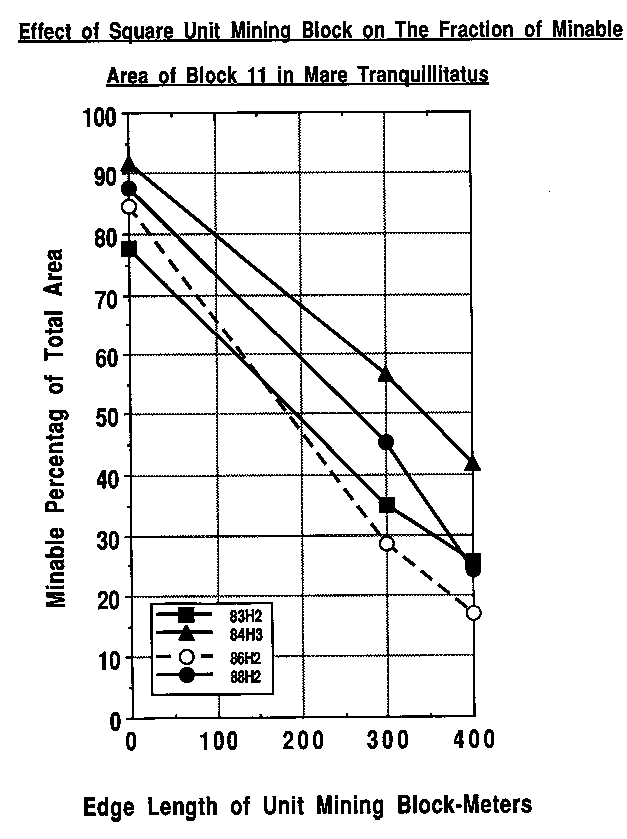 Minable percentage in relation to size of mining
block
Minable percentage in relation to size of mining
block
-
-
Spiral Mining (Schmitt, et al., 1992) -
Another approach to mining in cratered terrain is that suggested by circular irrigation systems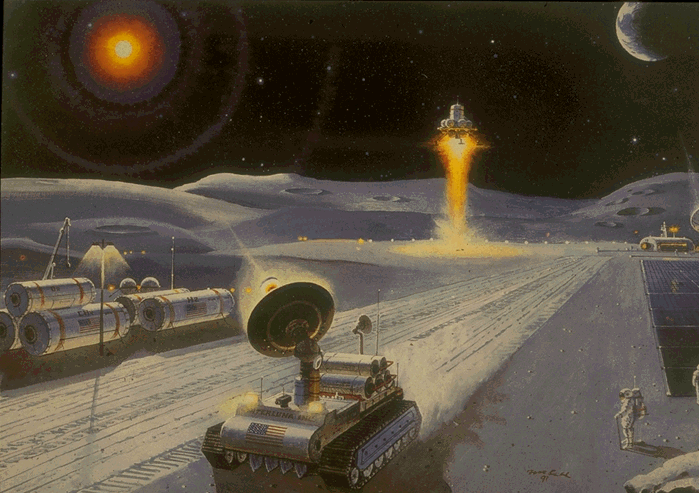 Artist view of lunar spiral (NASA art)
Artist view of lunar spiral (NASA art)
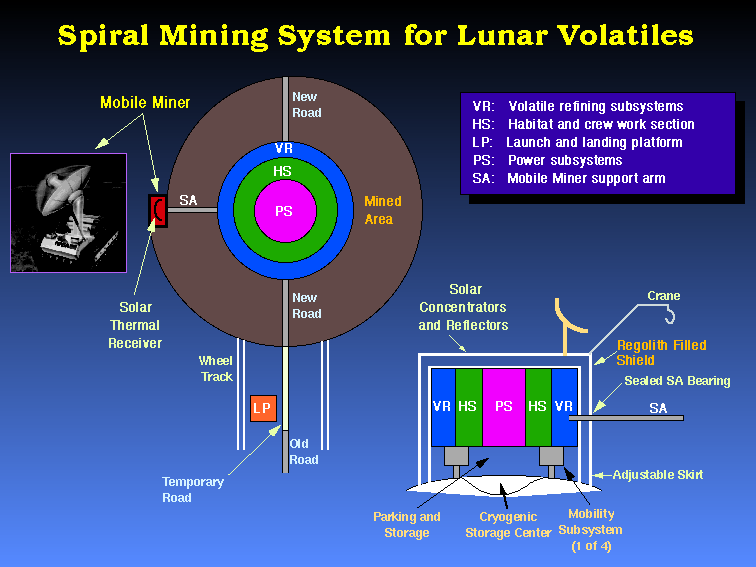 Spiral Mining system (Schmitt, 1992)
Spiral Mining system (Schmitt, 1992)
-
General Concept of Spiral Mining
- Mining progresses in a spiral, radially outward from a central, periodically mobile station.
- Regolith is beneficiated and volatiles are extracted and waste heat recovered in the miner
- Volatiles piped to central station for refining
-
Differences from Rectilinear mining
- Electrical power and thermal power received from central station
- Telerobotic operation possible along optical fiber
- Extracted volatiles pumped continuously to central station
- Refined volatiles can be shipped directly to users from central station
- Unsold volatiles can be stored under central station
- Routine maintenance and repair handled at central station
- Less demand on lunar base support means fewer lunar bases required.
-
Mobile Miner Characteristics: -
 Mobile Miner Characteristics:
Mobile Miner Characteristics:
-
Central Station Characteristics: -
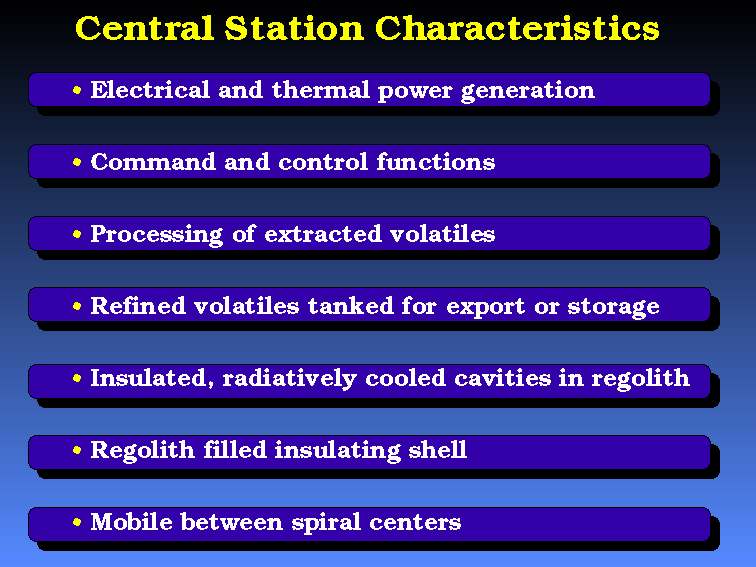 Central Station Characteristics:
Central Station Characteristics:
-
Standard Duty Cycle (solar thermal only)
- daytime: mining, beneficiation, and volatile extraction
- nighttime: volatile refining (use thermal radiation to deep space)
- with sufficient storage of solar energy (H2 + O2 = H 2 O cycle) or with nuclear energy production rates could be doubled)
-
Permanent Support Base (Logistics base)
- location should maximize access to the highest grade, lowest cost reserves and to the regional resource base
- permanent science base
- permanent settlement (?)
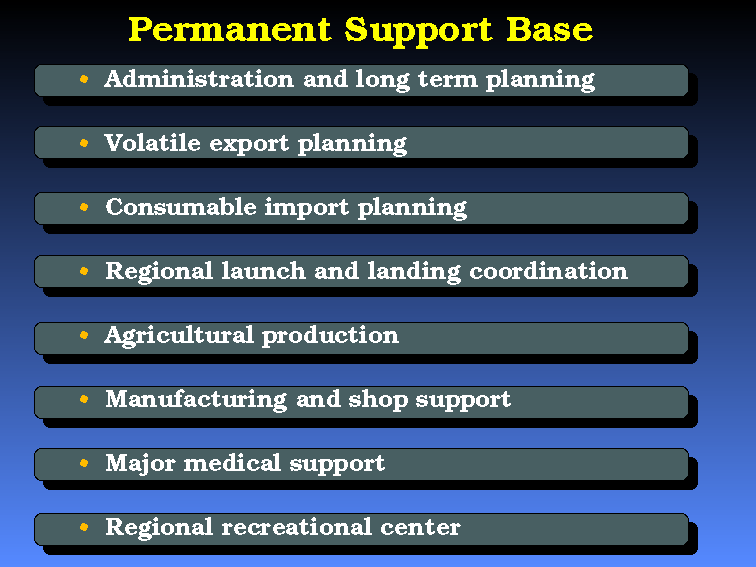
Questions:
1. Outline the types of geotechnical (geological engineering) data that would be required to design a Mark II-type miner.
2. Define the basic characteristics required by a cryogenic storage system placed within the lunar regolith and how could an impact crater be adapted to contain such a system.
3. Outline the trade-off considerations necessary to be able to choose between rectilinear and spiral mining concepts for mining 3He from the lunar regolith.
Text:
References:
Cameron, E.N., 1993, Evaluation of the Regolith of Mare Tranquillitatis as a Source of Volatile Elements, WCSAR-TR-AR3-9301-1, 15p.
Cameron, E.N., 1992, Helium Resources of Mare Tranquillitatis, Technical Report, WCSAR-TR-AR3-9207-1, 67p.
Chamberlain, P.G., et al., 1993, A review of possible mining applications in space, in Resources of Near-Earth Space, edited by J. Lewis, et al., University of Arizona Press, 51-68.
Ehricke, K. A., 1985, Lunar Industrialization and Settlement, in W.W. Mendel, editor, Lunar Bases and Space Activities of the 21st Century, p845, figure 3.
Neal, V., et al., 1988, Extravehicular Activity at a Lunar Base, Report on Advanced Extravehicular Activity Systems Requirements Definition Study, NASA-17779.
Schmitt, H.H., et al., 1992, Spiral Mining for Lunar Volatiles, in Engineering, Construction, and Operations in Space III (SPACE 92), edited by W.Z. Sadeh, et al., v 1, 1162-1170.
Back to Syllabus
 |
|
University of Wisconsin Fusion Technology Institute · 439 Engineering Research Building · 1500 Engineering Drive · Madison WI 53706-1609 · Telephone: (608) 263-2352 · Fax: (608) 263-4499 · Email: fti@engr.wisc.edu |
Copyright © 2003 The Board of
Regents of the University of Wisconsin System.
For feedback or accessibility issues, contact
web@fti.neep.wisc.edu.
|
